|
Dynamic Propeller Balancing
& Engine Vibration Analysis
Did you know 90% of all Propeller driven
Aircraft can significantly benefit from Dynamic Balancing!
"Dynamic prop balance is
the most cost effective thing you can do for your plane!" (Click here for
Link to AOPA article)
We Specialize
in Precision
Dynamic Propeller Balancing. We use the
Dynamic Solutions Systems
MicroVib II
Aircraft Analyzer, the finest dynamic balancing equipment available.
All work is completed and signed off by a certified A&P mechanic (not all repair
stations use certified mechanics). By having the work completed by a certified
mechanic, you can be sure that we will do it right the first time!
The MicroVib II
Aircraft Analyzer uses Mil spec aircraft vibration sensors and receives an annual calibration traceable to NIST.
The MicroVib II allows us to perform and record both dynamic prop balancing and
engine vibration analysis.
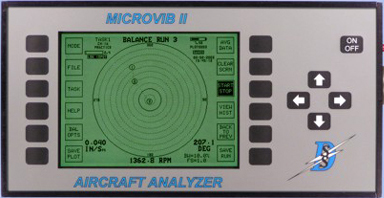
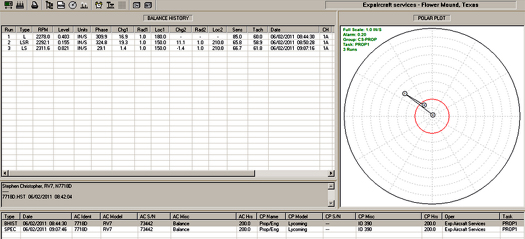
Above: Downloaded Balance History
Display/Polar Plot
Run 1) 0.403 IPS
Run 2) 0.155 IPS Run 3) 0.021 IPS
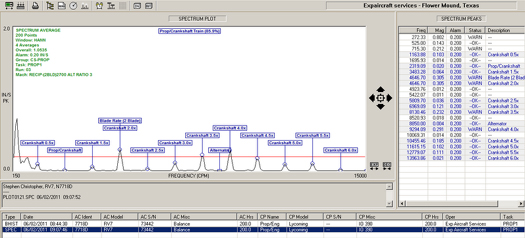
Above: Downloaded Vibration Analysis
Display
Why Should I Balance?
Recommended by Hartzell,
McCauley, and most Reciprocating and Turbine engine
manufacturers. We use accepted and approved balancing procedures as outlined in
manufacturers maintenance manuals and
FAA Advisory
Circular 20-37E.
Reduce
Maintenance Costs: Smoother operation means less component fatigue and
longer engine/airframe life.
Excess vibration will shorten the life of internal engine components, engine
accessories, alternators, avionics equipment, vacuum pumps, exhaust systems, engine baffling, spinners,
brackets and more.
Reduce Pilot/Passenger
Fatigue:
Vibration is a major element that increases wear and tear on airframes, but did
you know it also increases pilot and passenger fatigue? Numerous studies have
shown that vibration significantly contributes to pilot physical discomfort and
fatigue. Excess Vibration can also effect the bodies extremities, if you
find your hands or feet falling asleep during flight this is a good indicator of excess
airframe vibration. Less vibration means you'll arrive at your
destination feeling better.
We Guarantee Results:
We typically see beginning
vibration levels from 0.25 - 0.60 IPS (Inches Per Second) or more, anything
above 0.20 IPS is considered out of limits and requires balancing.
The industry standard
after balance limit is 0.15 IPS, this where your average balance shop will
say it's "good enough".
We
guarantee a level of 0.07 IPS or less after balancing, less than half the
industry accepted after balance limit!
How can we get results
like that you might ask, it simple; we take accurate measurements, we pay
attention to detail, we take the time to do it right, and we have the best equipment available to verify the final results.
Average balance job takes approximately 2 hours and 3-5 runs to accomplish.
Documentation: When the
job is complete we provide you with a computer printout documenting the entire process of dynamic balance
with beginning and ending levels, polar plot and
vibration spectrum analysis, and a signed log book entry placard. All records
are maintained for historical purposes in both digital and paper formats for
future reference.
Location & Wind Conditions: Winds
are usually not a problem unless gusts are very high (above 20 kts), the
MicroVib II is able to average multiple readings eliminating the wind/gust
factor that limits most other balancers to calm wind conditions.
Excessive
Vibration Symptoms include:
- Instrument panel shaking
- Cracking of engine baffles
- Generator/Alternator failures and mounts
breaking
- Exhaust system cracks
- Spinner and Spinner bulkhead cracking
- Feet "falling asleep" during flights
- Repeated instrument & avionics
failures
- Carburetor air box cracking
- Cowling and sheet metal cracking
- Cracked or broken engine mounts
Exp Aircraft Services Current Capabilities:
-
Fast, Accurate Dynamic Prop Balancing
-
Single and Twin engine
-
Engine Vibration Analysis
-
Vibration trend monitoring
-
Balance History Record Keeping
-
Vibration Troubleshooting
Tachometer Checks
(Turbine Engines coming
soon)
Vibration Range Limits
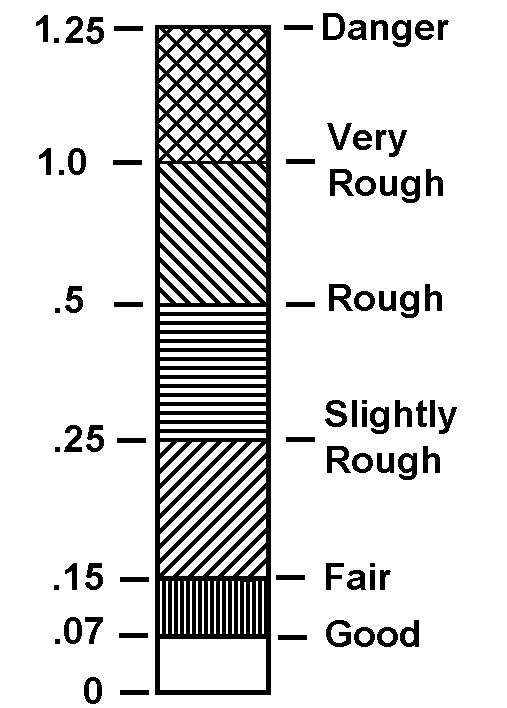
DANGER — 1.25 Inches Per Second (IPS) Peak Amplitude. The
propeller should be removed and a static balance performed.
VERY ROUGH
— 1.00 Inches Per Second (IPS) Peak Amplitude.
Propeller can be dynamically balanced; however a large amount of weight will be
required. A propeller static balance is recommended. Operation at this vibration
level could cause damage.
ROUGH
--- 0.50 Inches
Per Second (IPS) Peak Amplitude. Propeller definitely requires dynamic balance.
Long term operation at this vibration level could cause excessive wear.
SLIGHTLY ROUGH
-- 0.25
Inches Per Second (IPS) Peak Amplitude. Dynamic balance will improve passenger
comfort.
FAIR---- 0.15 Inches
Per Second (IPS) Peak Amplitude. This is the maximum acceptable vibration level
after dynamic balancing.
GOOD
---- 0.07 Inches
Per Second (IPS) Peak Amplitude. Vibration levels below 0.07 will not be
detectable by pilots or passengers.
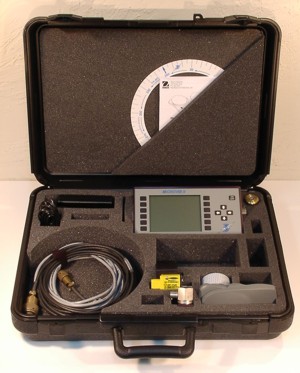
DSS MicroVib II Balance Kit
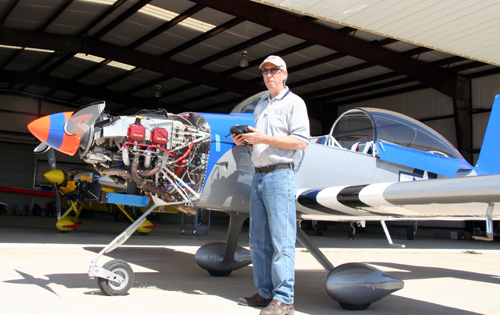
Prop Balance being accomplished on a Van's RV8A
FAQ: Dynamic Propeller
Balancing
What is dynamic propeller balancing?
Dynamic Propeller Balancing is the process
whereby an electronic balancer is used to measure the vibration produced by the
aircraft power plant. Small trim balance weights are added to the
propeller/crankshaft assembly to correct for errors in mass distribution and to
reduce power plant vibration due to mass imbalance to the lowest level
practical.
How is it done?
The engine/propeller combination is balanced
right on the aircraft, in a flight ready state. A small vibration sensor
(accelerometer) is attached to the engine in a location where vibration due to
mass imbalance is maximum. A small tach pickup (photo-tach) is also mounted to
the cowl or engine to produce a propeller tach signal. The engine is operated
and the vibration and tach signals are processed by the electronic balancer.
The balancer produces a vibration level
(magnitude) which corresponds to the amount of mass imbalance which
exists. The balancer also provides a "phase angle" which corresponds to the
location of the mass imbalance on the propeller disk. The vibration level
and phase angle are used to compute a balance solution (weight amount and
location). The balance solution is added to the propeller and the measurement is
repeated until the vibration level is found to be acceptable.
My aircraft runs fine. Why should I have
my prop dynamically balanced?
By all means, have your propeller balance
checked. The average airplane which has not had a Dynamic Prop Balance has a
vibration level due to propeller/crankshaft mass imbalance of about .450 inches
per second (IN/S) velocity. This level is more than four times higher than what
is considered to be an acceptable vibration level for propellers and represents
a significantly higher level of wear and fatigue on engine components and
accessories. This average level is usually very noticeable to the pilot and
occupants. Yours may be higher or lower than the average but only a mechanic
with a vibration analyzer can tell for sure. On the average, 19 out of 20
fixed-wing aircraft can benefit from Dynamic Prop Balancing yet many will never
have it done.
My engine and prop were overhauled
recently. Should I have my prop dynamically balanced?
Both new and used components need to be
dynamically balanced. In fact, the best time to dynamically balance a
propeller/engine combination is right after overhaul when components are fresh.
In the DSS study, no appreciable difference was found between the vibration
levels of recently overhauled and longer time propeller/engine combinations.
Even brand-new aircraft with zero time engines and propellers need to be
dynamically balanced.
What level of propeller vibration is
acceptable?
In most cases, the vibration level due to mass
imbalance can be brought down to under .100 IN/S very easily. In the DSS study,
the average level seen post-propeller balance was .039 IN/S. When propeller
vibration levels are this low, the operator will generally see a significant
reduction in component wear and fatigue and will find that the aircraft "feels"
like a completely different machine.
In addition to that the mechanic now knows what
all of the other engine vibration levels are (Prop/crankshaft mass imbalance
usually dominates them) and can utilize that information if additional work is
needed.
But won't having my propeller dynamically
balanced "mask" other engine problems?
No! An engine with an internal problem which
results in unusual vibration will not respond to balancing in the same way that
an engine which only suffers from mass imbalance will. A qualified mechanic will
use ALL of the information available to make a judgment about your engine,
including the vibration response.
THEORY: Reciprocating Engine Vibration
Piston Engine Vibration
An internal combustion engine produces power in
the form of controlled explosions. These explosions produce powerful pulses of
energy that cause the engine to vibrate in response. Engine designers do their
best to make these forces cancel out to minimize vibrations. But, no matter how
well the designer does his job, he cannot eliminate all inherent vibrations in
an engine. Therefore we need to remember that it is perfectly normal for an IC
(Internal combustion) engine to produce a characteristic vibration spectrum
signature. Vibration analysis of IC engines then must focus on "variations" from
the "normal" vibration signature.
Normal Vibration Signature
Each combustion pulse acts much like a hammer
blow, hitting the engine block with a pulse of energy. The vibration spectrum of
such a pulse is a series of vibration spectral lines. These spectral lines will
be at integer multiples of the firing rate of each piston. In a four stroke
engine the piston fires every other revolution, therefore the fundamental
spectral line will be at 1/2 the engine RPM, often called the 1/2 order
vibration. The result will be a vibration signature that has spectral lines at
the 1/2 order, 1P, 1-1/2P, 2P, 2-1/2P, 3P ... etc. In our experience, we have
found that most 4 and 6 cylinder horizontally opposed IC engine produce these
spectral lines in varying patterns but the levels are usually in the range of
.2-.5 IN/S. For unknown reasons we have found it is not uncommon for an engine
to produce a 2P or 2-1/2P vibration in the range of .5-1.0 IN/S. These readings
are taken on the ground at typically 2500 RPM.
1/2 Order Vibrations
It turns out that if all of the pistons produce
nearly identical combustion pulses, the 1/2 order vibration will be very small,
.1-.3 IN/S. When any one cylinder produces less power than the rest, the 1/2
order vibration will increase from .3 IN/S on up to over 1 IN/S for a misfire.
Mechanics know very well what can cause one cylinder to be weak. Plug misfire,
bad plug, plugged injector, broken ring, leaky valve, low compression, bad
magneto, worn cam, collapsed lifter, etc. Any of these things can cause a higher
than normal 1/2 order vibration.
1/2 order vibration are especially troublesome
as they can be felt in the cabin by the pilot. Low frequency vibrations are not
well isolated by most engine mounts, and the vibration will shake the entire
aircraft. If not taken care of, a 1/2 order vibration can loosen rivets, hinges,
and pivots all over the airframe, as well as causing premature pilot fatigue.
This is a serious safety issue.
1P Vibrations
1P vibrations are usually dominated by
propeller imbalance. Happily we can correct this with propeller dynamic balance.
1P vibrations can also be caused by unequal piston mass. Pistons and cylinders
are often replaced 1 jug at a time, and once in a great while the wrong weight
piston is used due to error. In horizontally opposed engines, this will produce
a 1P vibration in the horizontal plane, but little vibration in the vertical
plane. An out of balance prop will produce nearly equal vertical and horizontal
vibrations. If the rear of the engine has a high 1P vibration that is not
corrected by balancing the prop, piston mass imbalance is the most likely cause.
What are the causes of unwanted (excess)
cabin vibration?
An unwanted cabin vibration can be generated by
a variety of problems:
- Propeller mass imbalance (mass distribution problem)
- Propeller aerodynamic imbalance (blades not pitched equally or airfoils not
matched)
- Abnormal engine vibration (combustion problems or unmatched engine components)
- Normal engine vibration transmitted abnormally into the airframe (poor engine
to airframe isolation)
- Aerodynamic excitation of airframe by prop wash.
Why go to the trouble of balancing my
propeller first?
In each of the situations above, the very first
step in troubleshooting an aircraft vibration problem is to dynamically balance
the propeller. Because propeller imbalance is by far the most common cause of
excess cabin vibration, we eliminate the majority of cockpit vibration problems
with this first step.
Okay, so now my propeller is balanced,
what comes next?
After the propeller imbalance is eliminated,
other engine vibrations can be analyzed and traced to their source. A vibration
analysis signature is taken on the engine and then compared to signatures taken
from similar engine models. With some engines, a vibration signature check will
point to a combustion problem, perhaps caused by a dirty injector, a dirty spark
plug or an ignition problem.
Although rare, sometimes a vibration signature
check will point to an internal engine problem. When an engine problem is found
this way, the engine can usually be repaired before the problem becomes
unmanageable.
My engine vibration is normal, what is
causing my unwanted cabin vibration?
If
the engine vibration is reasonable, then vibration readings are collected in the
cabin so that the "felt" vibration can be evaluated. While the engine may be
producing "normal" vibration levels, these normal vibrations may be transmitted
abnormally to the airframe due to lack of isolation between the engine and
firewall. A vibration check can point the way to detection of isolation problems
such as bad engine isolators, hoses which do not have adequate service play,
exhaust system to airframe contact, etc.
What about aerodynamic excitation of the
airframe?
Even with good mechanical engine to airframe
isolation, vibration analysis can be used to detect and identify other unwanted
cabin vibration. The air mass which envelops the aircraft can provide a
transmission path for unwanted vibration. Any time the propeller is producing
thrust, propeller induced air pulses can excite parts of the airframe such as
thin or poorly attached windshields. With some aircraft, replacement of the
windshield with a thicker aftermarket unit will reduce cabin vibration
considerably.
Please contact us for more info.
|